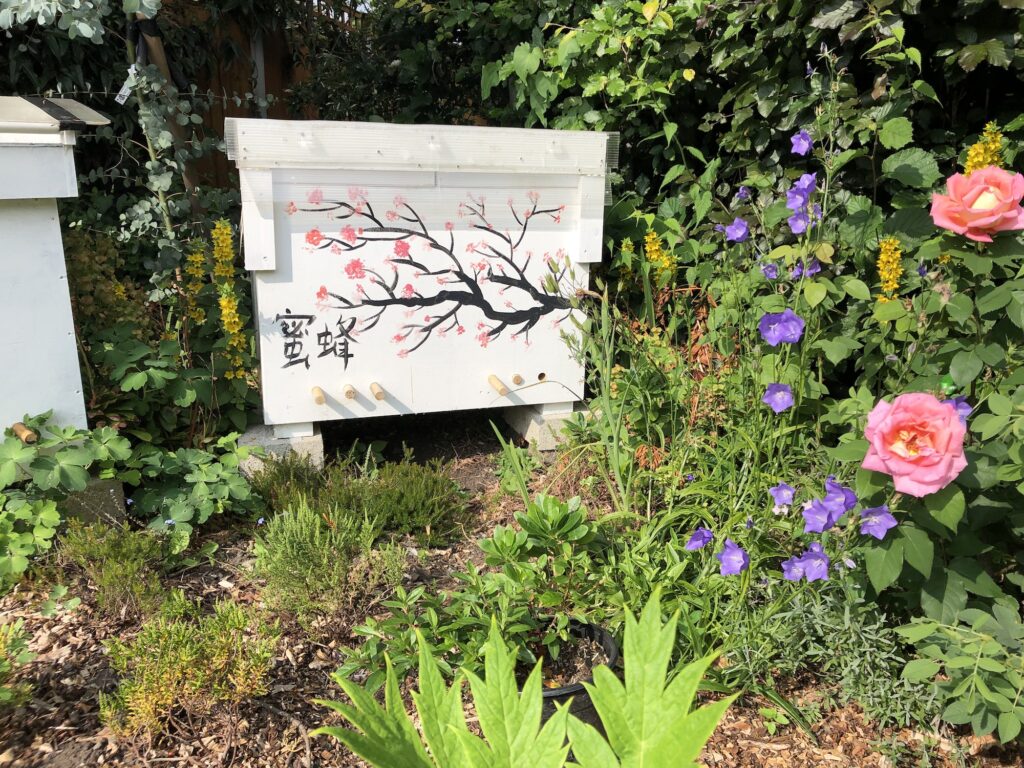
The Cherry hive was the second hive I built. It was done according to plans for the insulated Layens hive. The dimensions were adapted to accommodate the Einraumbeute frames we use. 9mm plywood was used for both the inner and outer walls. The chassis was made with 20x38mm planed timber. The roof was sloped and then covered with scrap polycarbonate for weather protection. Three 10mm holes provide ventilation. There is no mouseboard. The inner lip of the cover sits on Warre style quilts. As with the Manchester hive, there is a void of about 12cm below the frames, and an inspection/maintenance hatch. Raw wool insulation was used. The original roof failed to extend past the Warre-style quilts. I attached a strip of scrap polycarbonate to act as wind protection. In order to hinge the roof, I had to add two additional pieces of wood to meet the bottom of the roof.
Overall, my feelings are that this construction provides far less insulation than the Manchester hive. The wind gets under the polycarbonate and heat is lost from the sides of the quilts, even though they are filled with straw. Thicker pieces of plywood would have been better too. There is less propolisation due to the smoother surface of the plywood. Having said that, it is far lighter than the Manchester hive and the Hardwood hive, and much easier to move. Like the other hives, there are chest handles on the sides to facilitate manipulation. Another problem was that I had failed to stagger the inner and outer walls of the inspection hatch, and therefore there was a more significant gap. Also, because of less overhang of the roof itself, water tends to drip onto the inspection hatch and the wood began to delaminate towards the end of the season. I therefore had to use duct tape as flashing to protect it from further damage.
Therefore, the lesssons learnt from the Layens’ style construction are:
- Use thicker walls and rougher surfaces for the inner cavity
- If using a Warre-quilt, a deeper roof is required to cover the entire height of the quilt.
- Ideally, roofs should overhang the hive itself by at least 4-5cm all around to minimise water from dripping onto the lower edges of the hive.
- Inspection hatches are probably unnecessary (these are not included in Layens’ plans). But a void allows for some maintenance from the top.
2021
11 July 2021
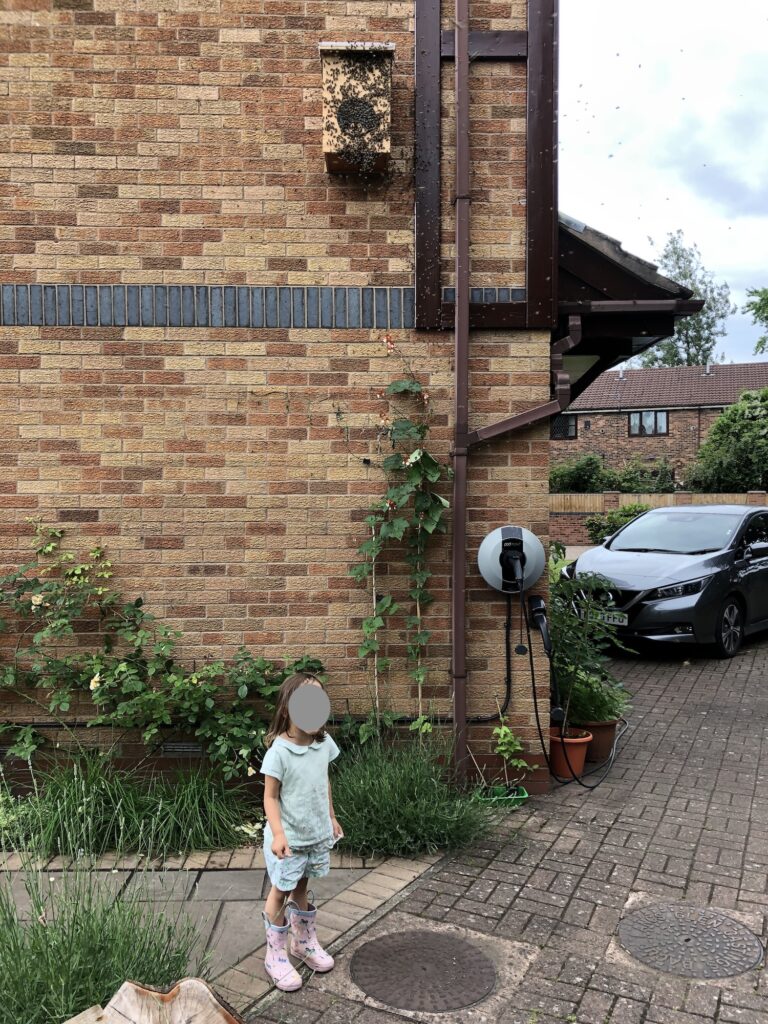
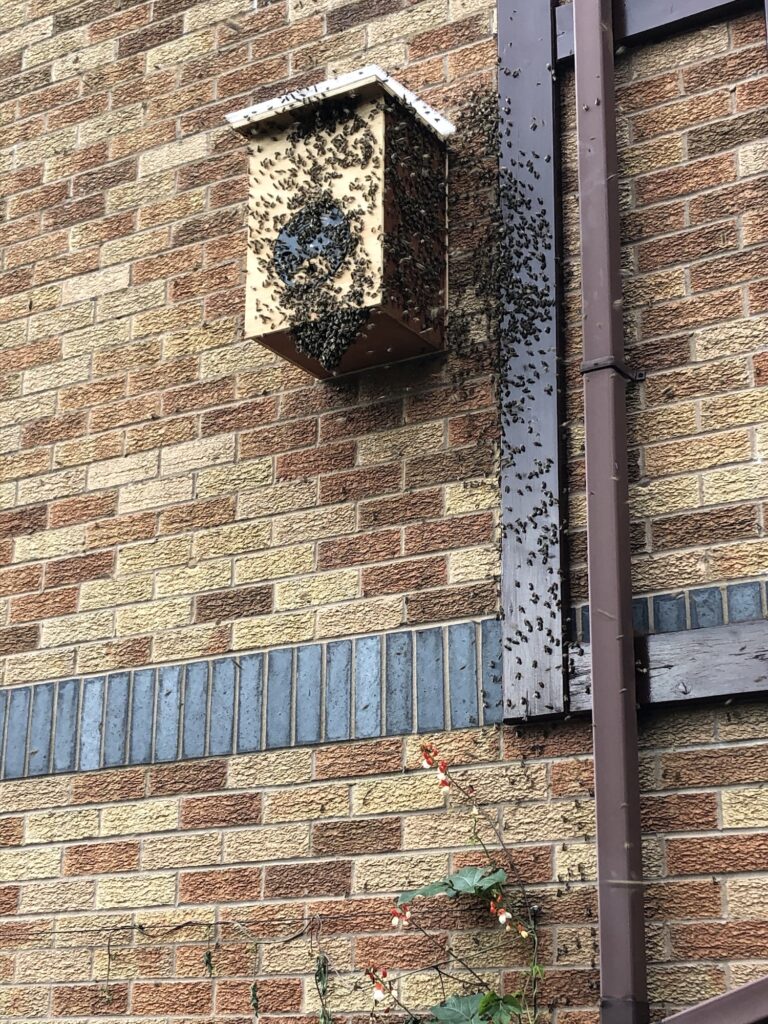
This was the day of an important football match for the English team. Over the previous few days, we had noticed scout bee activity on our swarm trap hung on the West side of the house. At approximately 1800hrs, a swarm of about 1kg arrived. I shouted to my wife who rushed out of the shower with our daughters. This was a magical first swarm experience, and the whole family watched as 10000 bees arrived, engulfed the swarm trap and walked in a counterclockwise direction as they slowly made their way into the trap. Our daughter danced around below the swarm. Bees near the entrace fanned their Nasanov scent – a subtle hint of lemongrass that we enjoyed a metre below the spectacle. They took over an hour to enter the trap. Several bees remained outside the trap, on the brick wall. The birth of a new colony was complete.
Inside this swarm trap was a single frame with old brood comb. This made it tricky to turn the trap around, and the old brood comb which was in there ended up crushing some bees. Therefore we stopped putting frames into swarm traps around the house, and instead just attached old brood comb to the walls of the swarm traps with melted beeswax. After sundown, the swarm was transferred into the Cherry hive by shaking and dumping. They were given 5 frames with some old brood comb attached to them.
17 July 2021
This was only a small peek. 2 frames with strips of foundation were added to make 7 frames. The old brood comb which fell down during the transfer was removed.
01 Aug 2021
The first inspection. Eggs and brood were seen. 7 frames were partially drawn. Approximately 1L of syrup fed. This was gone within 2 days. 2L more syrup was provided on 4Aug.
21 Aug 2021
3 additional frames added to make 10 frames, which was recommended according to the German ERB facebook group. 2 were subsequently removed as they were not drawn. 8 frames to overwinter.
2022
18 Mar 2022
It was a very warm and early spring this year in Manchester, so we inspected the Cherry hive on a sunny afternoon. It overwintered on 8 frames. None of the frames were fully drawn to bottom, but most were about 2/3 drawn. There were still plenty of honey stores, which suggests 8 frames is more than sufficient for overwintering. Brood was only seen on both sides of frame number 3, in a tight central distribution. We did however, spot the queen. She was very dark with very faint deep orange strips. Unfortunately, the cameras were not ready in time! We left the 8 frames without re-arrangement, hoping that they would continue to drawn the combs downwards to fill the frames completely, before thinking about expanding.
Over the next week, there was plenty of activity, albeit less vigourous than the Manchester hive. Around the neighbourhood, ornamental cherry blossom trees were in bloom, attracting honeybees and bumblebees alike. WIthin our garden, the hellebores, crocusus, Ribes, Prunus cerasifera and Prunus incisa provided nectar and pollen.
02 Apr 2022
We inspected the Cherry hive after the Manchester hive. Since there was a marked discrepancy in the amount of brood and activity seen between the hives, we were concerned about the Cherry hive. However, there was reassurance that colony build-ups are expected in late April.
There was small progress. Two frames contained capped worker brood. There was a modest increase in the number of bees on the combs. There was no drone cells seen. The queen was not seen, but there were sufficient stores and foraging activity had been noticed over the past fortnight. We did not add any frames.
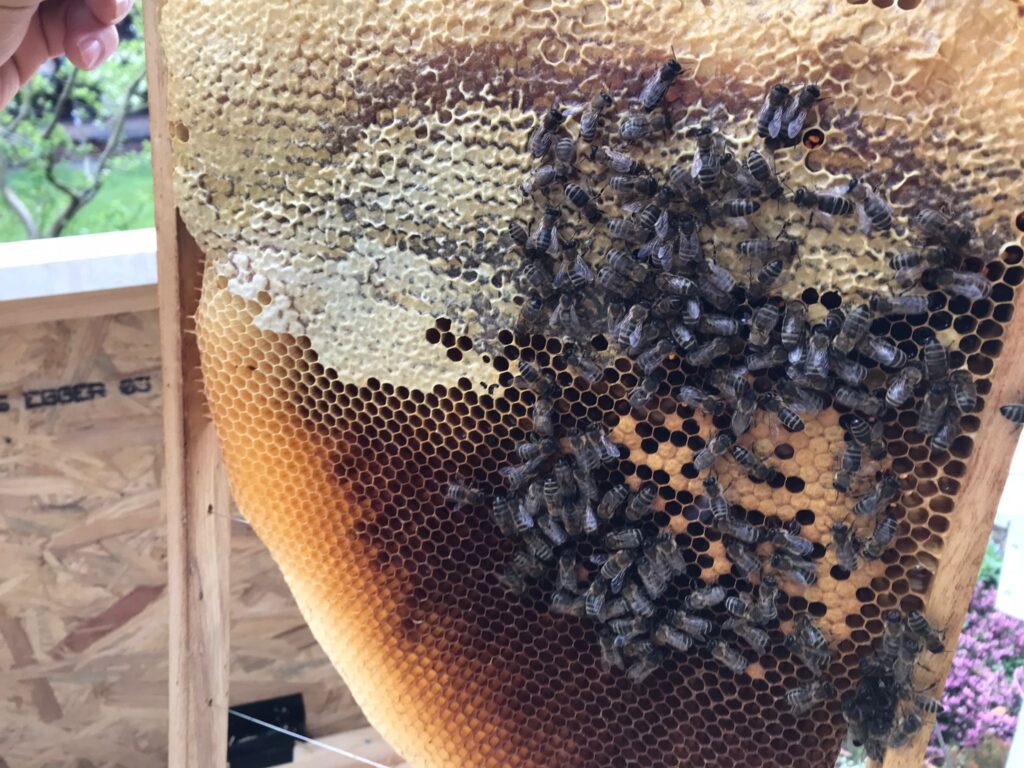
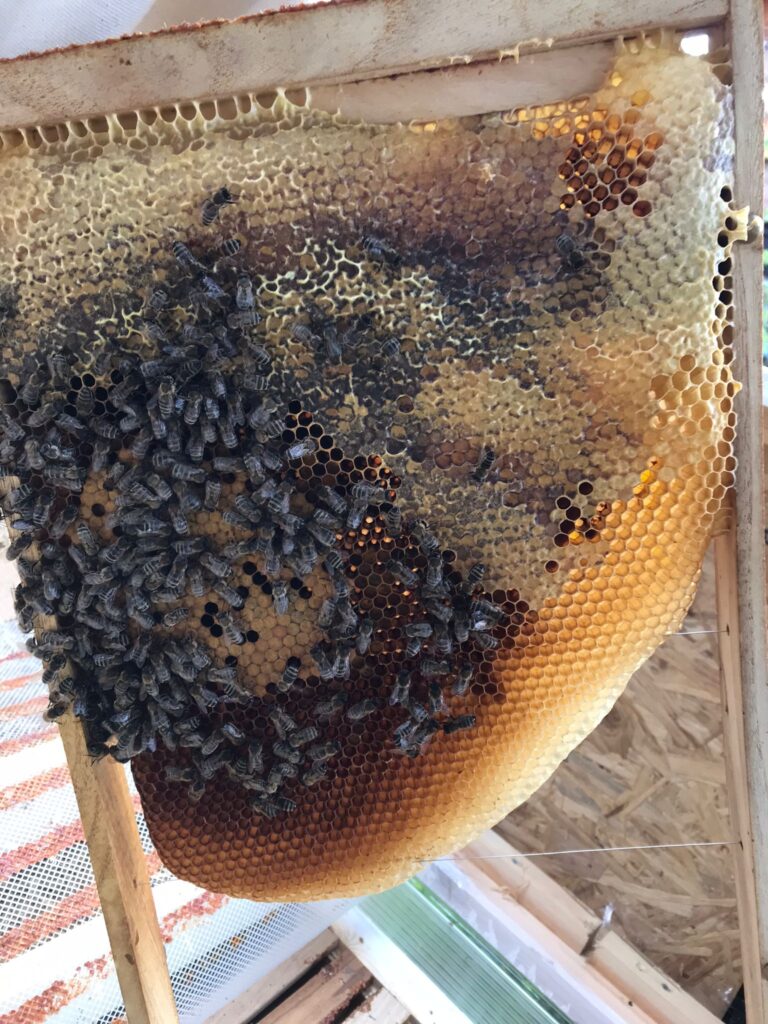
30 Apr 2022
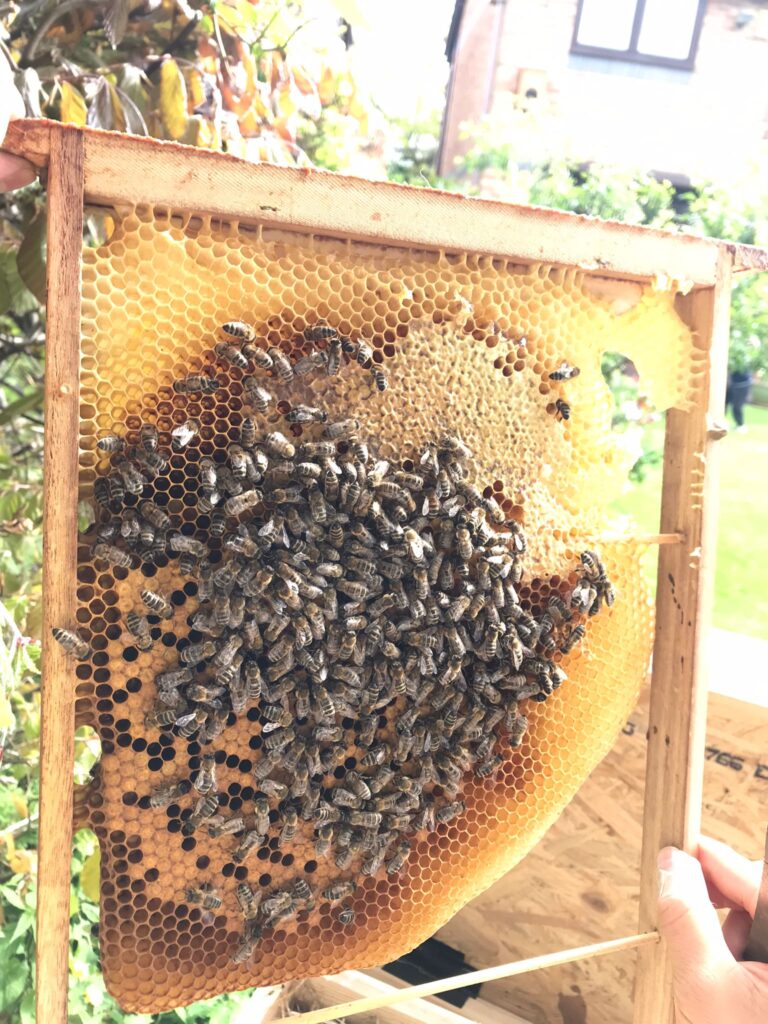
We inspected both hives. Weather was good. There was progress with brood, even though this was not apparent from observing external activity. Three frames contained capped worker brood, in a larger area than the previous inspection. There were no drone cells, nor queen cups. There were quite a bit of empty cells within the brood cluster. We were initially concerned it was pepperpot in appearance. However, open pupae looked good, there were no foul smells of foulbrood, the wax looked good and there were no other abnormal appearances. I sent a picture to my mentor, who thought it was normal; either there were varroa-control hygienic measures taken, or there are heater bees (Jurgen Tautz). We were assured and did not add any frames.
11 May 2022
The Cherry hive continues to slowly build up, with increasing activity at the entrace, although nowhere close to that of the Manchester hive. Nevertheless, since they had overwintered and were slowly building up, we opted to leave them alone. No inspection was done.
11 June 2022
Full inspection. Some progress on number of bees and brood. This has already been manifested as increased activity at the entrance over the past few weeks. Still a very small colony with little stores. Still 8 frames, only half to 3/4 drawn.
27 June 2022
Quick peek to see that bees were progressing, filling drawn comb with honey. Bees were seen up to final frame. However, frames were not fully drawn down so none added at present.
05 July 2022
Some further progress with plenty of activity at entrace. Limited inspection. Final two frames were at least 2/3 drawn. Drone cells seen on 2nd last frame. 1 frame added to make 9 frames in total. No plan for harvesting this year.
2023
17 Mar 2023
Over winter, we remained worried about the Cherry hive. While the three other hives continued to fly during nice days in winter, there was no activity in the Cherry hive. Indeed, they had died. The small number of bees were littered on the floor of the hive. I cleared them up. Two of the nine frames were half full of honey. These were harvested. There was one empty frame. The other six had modest amount of capped honey. I left them for a new colony this year (I’m hoping to get a swarm from the Freedom hive or one from another swarm trap in North Manchester). Besides a couple of small areas of fungus growth, the rest of the comb looked good and healthy. There was no evidence of wax moth or other obvious invaders.
27 Jun 2023
There were reports of many swarms around the country this year. For a few days, there was heavy scout activity at the swarm trap on the West side of the house. The trap on the north side was not as popular, probably because I didn’t put any swarm attractant. On Friday morning, the Freedom Hive swarmed. Our nanny caught the spectacle on her camera. By that afternoon the scouts were on the swarm trap. I do not know if they were from the Freedom Hive swarm. On 27 Jun (Sat), at approximately 1300hrs, a 2kg swarm arrived to the West trap. This was problematic, as it arrived just as we were about to leave for Scotland for a weeks holiday. The whole family saw the swarm arrive from the North. It was of a significant size but very quickly went into the trap within about 30mins. We decided to delay our departure to Scotland, which was possible since we were driving. However, we did not really want to wait till the evening to transfer the swarm to the Cherry hive, nor did we want to leave the swarm in the trap for a week. The former option would have resulted in calmer bees with less flight upon installation. The latter option would have resulted in wild comb built within the trap (there were no frames in the trap). So consulting with another beekeeper, we decided to transfer the swarm immediately to the hive that afternoon. At this time though, our little daughter Lydia was very cranky, requiring a nap, so by the time I got her down to sleep, there were already some orientation flights at the trap.
We installed the swarm into the Cherry hive the same way we’ve previously done. First the trap was cam-strapped tight after the entrance closed. There were a couple of handfuls of straggler bees. Next the trap with the swam was weighed. After that, I lifted the lid (with the cluster) and shook them into the prepared hive. Then, the trap itself was turned upside down and shaken. Finally, the hive was closed and the open trap placed towards the entrance of the hive. Because this was done at about 1400hrs, I had to work fast. Many bees immediately took flight after being dumped into the hive. The existing comb was alternated with some empty frames to make 9 frames in total. A week later, when we arrived home from Scotland, there was good foraging traffic in and out of the Cherry hive.
Oct 2023
Winter preparations began. I did not do an inspection, but noted that the last frame was partially drawn. The bees have been very busy and the hive seems healthy. Hemp coffee sack filled with wool was placed into the void. Entrances were reduced to a single one. I probably won’t bother with mouse guards.
2024
11 Apr 2024
First inspection of the season done with friends Mike and Carolyn. Good activity seen throughout winter and early spring despite the atrocious weather. Hive was clean and dry, including the wool pillow in the lateral void. Bees content and good brood pattern seen. Limited stores present. Some diarrhoea had been seen at the entrance.
20 Apr 2024
2 frames added in alternate fashion to make 11 frames. 2-3 frames of brood with good pattern.
22 Jun 2024





The Cherry hive was built according to Leo Sharashkin’s design. However, I’ve noticed a flaw in the roof design. Because there is little overhang, rain tends to drip onto the bottom part of the hive. This, in combination with the low quality/cheap plywood I used for the outer shell, meant over the last 3 years there has been significant water damage to the bottom edges. This was most prominent at the bottom corner of the maintenance hatch, which has rotted to expose the inner frame.
So over winter, I constructed a replacement hive. The elements of this hive are: inner walls of rough sawn fencing slats leftover from an old panel. 50mm of wool as insulation. Outer walls made of 12mm marine plywood. 15degree pitched roof with plastic roofing.
We transferred the colony over on 22 June 2024. This involved: (1) moving the Brown hive to the back of the Cherry hive, (2) removing both roofs, (3) swapping places of hives, with the Cherry hive behind and Brown hive in place on the ground blocks, (4) transferring all the frames, (5) leaving the empty Cherry hive open for another couple of days for the bees to find their way to the new hive. Overall, it seemed to work quite well, and by the next day, there were lots of orientation flights.
The Cherry hive is now in the garage for repairs. This page will continue as the Cherry/Brown hive for now.
13 Jun 2024
We had assumed, wrongly, that the lack of brood several weeks ago was due to a starvation brood break. The weather conditions have been unfavourable, and indeed many other beekeepers have noticed that their hives were starving. The Cherry hive was low on stores, but not starving.
Over the past few weeks after transfer to Brown hive, we noticed that activity continued to dwindle. On inspection today, I noticed a weak colony, probably drone-laying queen (or worker), centrally distributed drone-comb pattern, and some wax moths on the comb furthest from the entrance. Very few bees (mostly drones and some workers), and no queen seen.
I opted to take a full comb of brood from the Manchester hive and transfer, hoping that they will raise a new queen. Time will tell.

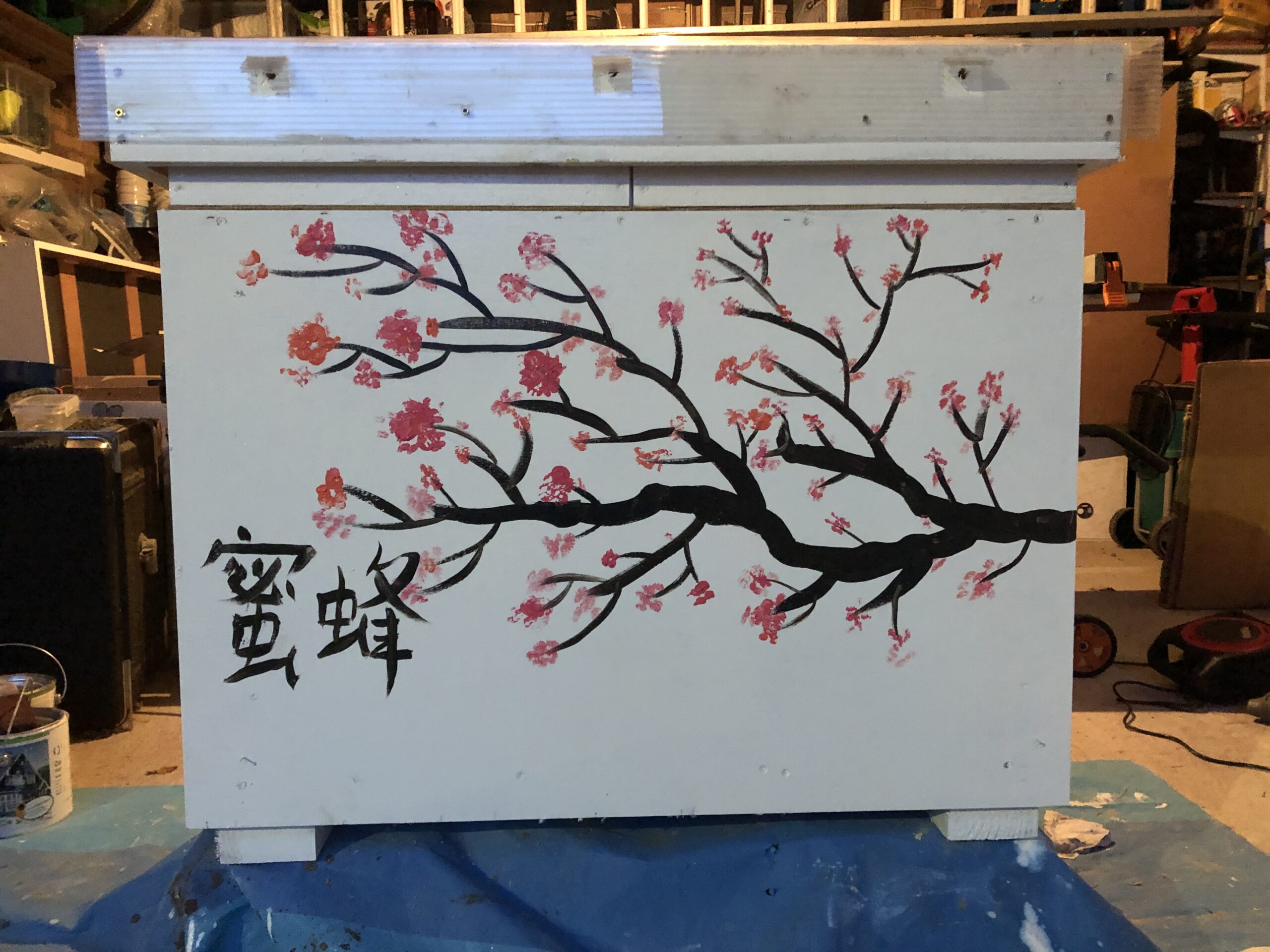
[…] C = Cherry hive […]
[…] house. We don’t know where this swarm went, and whether it eventually came back to our own swarm trap on 27 Jun […]